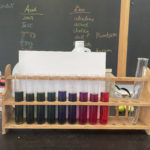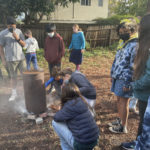
Step into 7th Grade Chemistry
by Cathy Waheed | Class Teacher
 In their chemistry main lesson block this month, seventh grade students made a purple cabbage indicator which was used to test acids and bases. The purple pigment, anthocyanin, in purple cabbage acts as the indicator. The photo shows the tests we did from left to right on lye (sodium hydroxide), the most basic; washing soda (sodium carbonate), ammonia, baking soda, distilled water (a neutral substance, so the indicator color remained purple), boric acid, vinegar, lemon juice, and hydrochloric acid, the most acidic.
In their chemistry main lesson block this month, seventh grade students made a purple cabbage indicator which was used to test acids and bases. The purple pigment, anthocyanin, in purple cabbage acts as the indicator. The photo shows the tests we did from left to right on lye (sodium hydroxide), the most basic; washing soda (sodium carbonate), ammonia, baking soda, distilled water (a neutral substance, so the indicator color remained purple), boric acid, vinegar, lemon juice, and hydrochloric acid, the most acidic.
 As part of our studies of the lime cycle, we built a lime kiln (in the picture with the smoke) and heated a piece of marble (a salt) all day to create quicklime (a base). We then slaked it by adding water (slaked lime is a base) to create a mortar. The mortar was made with the slaked lime by adding sand to make a putty-like substance. We stuck some bricks together with our mortar. As it dries, it becomes a salt again. This was done by the Ancients to use in construction. The Romans mixed it with volcanic sand so it would cure underwater. This is how they built their aqueducts across rivers.
As part of our studies of the lime cycle, we built a lime kiln (in the picture with the smoke) and heated a piece of marble (a salt) all day to create quicklime (a base). We then slaked it by adding water (slaked lime is a base) to create a mortar. The mortar was made with the slaked lime by adding sand to make a putty-like substance. We stuck some bricks together with our mortar. As it dries, it becomes a salt again. This was done by the Ancients to use in construction. The Romans mixed it with volcanic sand so it would cure underwater. This is how they built their aqueducts across rivers.
